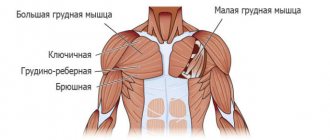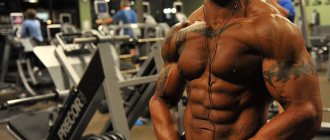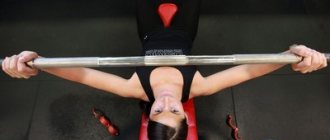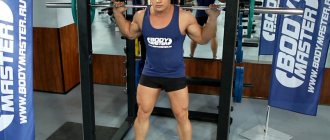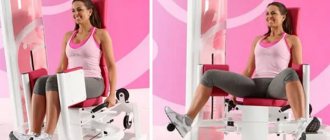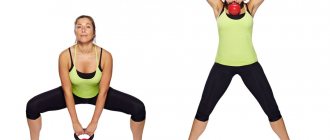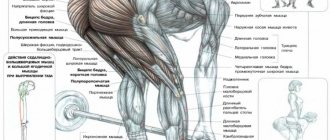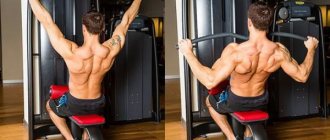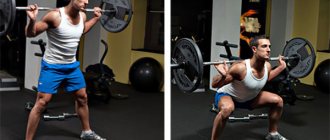- December 18, 2018
- Workouts in the gym
- Nikita Novikov
How long does it take to pump up your pectoral muscles? What are the best exercises for chest training? How to pump up your pectoral muscles at home? Is it possible to pump up your pectoral muscles with push-ups? These questions interest many novice athletes. In the publication you can find answers to your questions. To find out how long it takes to pump up your pectoral muscles, we recommend reading this article to the very end. This way you won’t miss anything important and will receive a lot of useful recommendations.
Anatomy
Exercise and frequency of training is, of course, a very important topic, but first it would not hurt to understand the anatomy of the muscle group discussed in the article.
The chest is divided into two muscles:
- Pectoralis major muscle. This is the name given to the fan-shaped muscle, which is located in front of the chest. The pectoralis major muscle begins on the pectoral bone in the center of the chest and attaches to the humerus near the shoulder joint. Its main function is to flex the humerus toward the chest.
- Pectoralis minor muscle. This muscle is located under the pectoralis major muscle. It begins approximately in the middle of the chest and is attached to the coracoid process of the scapula. The main function of this muscle is to move the shoulder forward.
The serratus anterior is located below the level of the pectoralis major and minor muscles.
In addition, the pectoral muscles can be divided into three bundles: upper, middle and lower.
Well, we've sorted out the theory, now let's move on to practice. Let's start by discussing the most popular chest exercises in the gym.
Horizontal barbell press
The bench press is a basic exercise that, in addition to the pectoral muscles, actively works the triceps and anterior deltoids. It is performed at the beginning of training, when the athlete is still full of strength and energy.
Technique:
- Lie down on a horizontal bench so that the bar is at eye level. Grab the barbell with a wide grip. Remove the projectile from the racks (by yourself or with the help of a partner).
- While inhaling, slowly lower the barbell down. The bar should touch the middle or lower chest.
- As you exhale, press the barbell up with a powerful movement.
- Repeat the movement as many times as necessary.
Exercises on simulators
Depending on the goal being pursued, you can exercise in the gym according to three programs:
- To ground;
- On strength;
- On the relief.
The last point can be ignored, since it is needed only for professional athletes with extensive training experience and developed muscles.
They perform it before competitions, or to give their body an aesthetic appearance. To do this, they pump the inner part of the pectoral muscles or other lagging areas.
Strength and mass training vary in the weight used.
An athlete who wants to develop strength must work with an apparatus that can lift a maximum of 5 times. This contributes to maximum damage to muscle tissue fibers, which, when restored, become stronger and larger.
At the same time, the increased load on the nervous system helps to thicken the fatty protection of neurons, thereby increasing maximum force.
The great advantage of strength training is the comprehensive development of the whole body. There is a gain in mass and strengthening of the tendons.
Mass training is designed to only damage the maximum number of muscle fibers in all muscles. Lighter weights are used for this.
Standard lifts are those that the athlete can lift 8-12 times.
Thanks to this, failure of a certain group does not occur longer, which allows for better development of auxiliary areas.
Horizontal Dumbbell Press
The main advantage of dumbbells is that they can be used alternately. In this way, the athlete can not only correct the imbalance, but also force the pectoral muscles to work interconnectedly, bringing the arms together at the top point to achieve maximum contraction.
The technique of performing a dumbbell press is in many ways similar to the technique of a barbell press:
- Grab some dumbbells (by yourself or with the help of a partner) and lie down on a bench. The projectiles should be at the level of your chest.
- As you exhale, press the dumbbells up toward your center. At the top point, do not extend your arms completely to maintain tension in the muscles. Don't let the projectiles touch.
- As you inhale, gently lower the dumbbells to the starting position.
- Do as many repetitions as you need.
Article from Muscle & Fitness 2012 No. 1[edit | edit code]
If the pectoral muscles can surprise you with anything, it is their gigantic size. The goal of gaining maximum muscle volume is rightfully considered the main one here, and therefore should be at the very center of your training strategy. The key to huge pecs is strict adherence to the classic rep range (8-12 reps per set). Low-rep powerlifting-style sets won't help much here. And don't let the veterans' extreme weights fool you. Many of them just amuse their vanity with records. Remember, any set you perform must fit into a proven repetition scheme.
TO GROUNDS
- Bench press 5x8
- Dumbbell Incline Press 3x12
- Barbell head down press 3x12
- Crossovers on 5x10 blocks
NEWBY
- Push-ups 3x10
- Dumbbell bench press 3x10
- Dips 3x10
- Details of dumbbells lying 3x10
TRAINING AT HOME
- Push-ups on the floor 3x20
- Dumbbell floor press 3x12
- Details of dumbbells on a 3x12 ball
ONLY 15 MINUTES!
- Dumbbell bench press 3x10
- Push-ups (legs on support) 3x15
- Hand raises in the 3x20 simulator
FOCUS ON BOTTOM BREASTS
- Barbell head down press 3x12
- Dumbbell head down press 3x12
- Dumbbell head down curl 3x15
- Dips 3x to failure
EMPHASIS ON THE UPPER CHESTS
- Incline bench press 3x12
- Dumbbell Incline Press 3x12
- Oblique hand raises on 3x15 blocks
- Push-ups (feet on support) 3x12
FORCE!
- Bench press 5x5
- Dumbbell floor press 3x6
- Push-ups on the floor with cotton 5x5
- Dips with weight 3x to failure
CIRCULAR TRAINING
- Bench press 4x10
- Push-ups on the floor 4x10
- Dips 4x10
- Alternating dumbbell press on a 4x10 ball per arm
Lifting with dumbbells lying down
Flying with dumbbells in a lying position is aimed at isolated chest work. It is usually performed at the end of the workout. The main advantage of the fly is that it puts a shock load on the chest and excludes the triceps and other third-party muscles from the work as much as possible.
Technique:
- Lie on the floor (it is advisable to lay a special mat), pick up dumbbells and lift them in front of you.
- As you inhale, smoothly spread your arms until your elbows touch the floor. Your arms should be slightly bent at the elbow joints. Don't bend them too much so that the pinch does not automatically turn into a dumbbell press.
- As you exhale, bring your arms together in front of you.
- Do the required number of repetitions.
Weight-bearing exercises[edit | edit code]
- Bench press with the head end of the bench raised
- Dumbbell flyes with the head end of the bench raised
- Army press
- Lifting a barbell or dumbbells in front of you
- Bench press with the head end of the bench down
- Pullovers
- Dumbbell flyes with the head end of the bench lowered
- Dumbbell flyes on a horizontal bench
- Bench press on a horizontal bench
- Dumbbell flyes on a horizontal bench
- Bench press with the head end of the bench raised
- Dumbbell flyes with the head end of the bench raised
- Dumbbell flyes lying on the floor
- Army press
- Lifting a barbell or dumbbells in front of you
- Bench press with the head end of the bench down
- Pullovers
- Dumbbell flyes with the head end of the bench lowered
- Dumbbell flyes on a horizontal bench
- Bench press on a horizontal bench
- Dumbbell raises
- Dumbbell push-ups
Bringing hands together in crossover
Another exercise aimed at isolated chest work. This is done as follows:
- Take the two D-shaped handles located on the top of the crossover and stand between the posts of the machine. To avoid stress on your joints, bend your elbows slightly. Place one foot forward and spread your arms wide.
- As you exhale, lower your arms forward in an arcing motion to waist level.
- As you inhale, return your arms to the starting position.
- Complete the number of repetitions you need.
Smith Machine Bench Press
This exercise is well suited for people who, for one reason or another, cannot perform the classic bench press. In addition, it can be performed at the end of a workout as a “finishing” exercise for the chest.
The technique of performing a bench press in a Smith machine is practically no different from the classic bench press in a horizontal position. The only difference is that, firstly, in Smith you press along a clearly defined trajectory, and secondly, in the initial position the bar is at the level of your chest, and not at eye level.
These are not all exercises for the chest muscles, we just talked about the most popular and effective ones. If we devoted time to absolutely all chest exercises, it would take dozens of sections.
Selective chest training[edit | edit code]
Main areas of influence of various exercises
To summarize, I would like to draw attention to the fact that all exercises involve the pectoral muscle almost completely, however, almost every exercise has its own emphasis on a specific area. Below are exercises for training individual chest areas.
Upper chest exercises[edit | edit code]
- Bench press with the head end of the bench raised
- Dumbbell flyes with the head end of the bench raised
- Head down push-ups
- Army press
- Lifting a barbell or dumbbells in front of you
- Bench press with the head end of the bench raised
- Dumbbell flyes with the head end of the bench raised
- Head down push-ups
- Army press
- Lifting a barbell or dumbbells in front of you
Exercises for the lower chest[edit | edit code]
- Bench press with the head end of the bench down
- Pullovers
- Pushups
- Dips
- Dumbbell flyes with the head end of the bench lowered
- Bench press with the head end of the bench down
- Pullovers
- Pushups
- Dips
- Dumbbell flyes with the head end of the bench lowered
How to pump up lagging bundles of pectoral muscles?
Quite often it happens that an athlete has a well-developed lower chest, but the upper chest is seriously lagging behind. This is due to the fact that when pressing in a horizontal position, the middle and lower bundles of the pectoral muscles receive the main load. How to fix it? It's simple. It will be enough to change the angle of inclination in bench press exercises. The angle should be no more than 30-45 degrees, otherwise the load will be “eaten up” by your deltoids.
A similar scheme can be used if your lower chest lags behind. Only in this case you need to do the exercise upside down with a slope of 20-40 degrees.
Important! If you suffer from high blood pressure, it is not recommended that you perform exercises in this position!
How many times a week should you pump your pectoral muscles to see the first results faster?
We have specifically dedicated a separate section for this issue. How long does it take to pump up your pectoral muscles? We want to say right away that your success in pumping up your breasts depends on a large number of factors. These include genetics (for some people, breasts grow quickly, while for others, on the contrary, slowly), frequency of training, nutrition, correctness of exercises, etc. As practice shows, if you train regularly, eat right, recover properly After training, perform each exercise technically, then the results can be seen already in the first months of training.
How often can you pump your pectoral muscles? Many people mistakenly believe that the more often they exercise their breasts, the faster they will grow. In fact, this is completely wrong. Due to frequent training, the pectoral muscles will not recover in time, which will greatly slow down muscle growth and lead to a drop in strength indicators. Experts agree that one hard workout per week is more than enough. If nature has not endowed you with good genetics for the pectoral muscles, you can add another, easier workout per week.
How long does it take to pump up your pectoral muscles? We've sorted this issue out, let's move on.
Supplements for pumping up the pectoral muscles
Basic set
Advanced
Basic set
Basic set
Advanced
MAXLER | Ultrafiltration Whey Protein ?
- We take the first portion of whey protein before breakfast, the second between meals before training, and the third, double, after training.
- Category: Whey Protein More about the category
1 serving each.
To meet the needs of modern athletes, we have included MAXLER® Ultrafiltration Whey Protein in our range to help maintain adequate protein levels in the body.
MAXLER | Creatine Caps 1000 ?
- We take creatine after training.
- Category: Creatine capsules More about the category
5-6 capsules can be taken as protein.
Creatine monohydrate MAXLER® Creatine Caps 1000 from a branded manufacturer from Germany MAXLER is a 100% natural creatine monohydrate, which is available in free natural form.
MAXLER | Vitamen?
- Take the tablets throughout the day, preferably with food.
- Category: Vitamin-mineral complex More about the category
3 tablets per day
The German company, known in the global sports nutrition market for many years, has released a balanced complex of vitamins and minerals in one package - Maxler USA Vitamen
Universal Nutrition | Un Proton 7?
- You can take Universal Nutrition Proton 7 protein mixture at any time of the day.
- Category: Multi-component protein More about the category
Mix 1-2 scoops of product in 230-470 ml of water or juice.
Universal Nutrition Proton 7 is a multi-component protein mixture designed to constantly replenish muscles with amino acids.
Universal Nutrition | Daily formula?
- You only need to take the supplement once a day.
- Category: Vitamin-mineral complex More about the category
One tablet immediately before meals (preferably before breakfast).
UN Daily Formula is a highly effective multivitamin and mineral complex that, in addition to the basic elements, contains a set of specially selected enzymes that promote the rapid absorption of essential nutrients.
Universal Nutrition | Calcium Zinc Magnesium ?
- 1-3 times a day.
- Category: Minerals
1-3 tablets.
Universal Nutrition Calcium Zinc Magnesium is a complete vitamin and mineral complex for athletes experiencing significant physical activity, which results in the threat of irreversible changes in the musculoskeletal system.
Universal Nutrition | Amino 2700?
- The supplement is taken twice a day, regardless of the athlete’s weight.
- Category: Amino Acid Complex More about the category
4 tablets before and immediately after training.
UN Amino 2700 is a modern amino acid complex that is derived from pure whey protein, and therefore has exceptional effectiveness and comprehensive effects.
Universal Nutrition | BCAA Pro?
- Combine with an amino acid complex and take before and after training.
- Category: BCAA More about the category
2 tablets each.
1
Ultimate Nutrition | Kre-Alkalyn?
- Recommended only on training days. In the morning and after training.
- Category: Creatine with transport system More about the category
2 capsules each.
Creatine with the Universal Nutrition Kre-Alkalyn transport system is notable because when it is transported into muscle tissue, it does not break down into harmful byproducts such as creatinine.
Universal Nutrition | LAVA?
- Take Universal Nutrition LAVA just once a day, one serving after training.
- Category: Special Sports Supplements
To do this, 2.5 scoops are mixed with 250 grams of water.
UN Lava is an exceptional quality product that is designed to seriously increase the intensity of your workouts in order to quickly and effectively gain muscle mass.
Sports nutrition recommendations are indicative only. Before purchasing, we recommend that you consult with a specialist in the store.
Conclusion on working out the pectoral muscles with dumbbells
Remember: nothing is impossible for a person who has set a goal and stubbornly pursues it. Pumping up your chest with dumbbells is real. Pumping up your chest with push-ups is also possible. The only question is, do you have the patience to get to the finish line?
We believe in your perseverance and fortitude. Prove that we were not mistaken about you!
FITNESS EXPERT Evgeniy Avvakumov: You can sign up for online training with me, get a training plan or sign up for full support - through the TrainWith.Pro service
Example training program
The most popular and most effective training system is the three-day split. It looks something like this:
- Monday: chest and triceps workout.
- Tuesday: rest.
- Wednesday: back and biceps workout.
- Thursday: rest.
- Friday: shoulder and leg workout.
You can also train antagonist muscles in one day:
- Monday: chest and biceps workout.
- Tuesday: rest.
- Wednesday: back and triceps workout.
- Thursday: rest.
- Friday: shoulder and leg workout.
Thus, your chest training falls on Monday. An average chest workout looks something like this:
- Incline bench press: 3 sets of 8 reps.
- Dumbbell bench press in a horizontal position: 3 sets of 10 reps.
- Dumbbell flyes upside down (if you don't have pressure problems): 3 sets of 10 reps.
- Crossover curls: 3 sets of 12 reps.
It’s worth saying right away that this is just an example of chest training. It may work for some people, but not for others. There is simply no universal program that would suit absolutely everyone.
How to start practicing
Depending on the initial level of training of the athlete, he needs to either prepare or immediately go to exercise machines to pump up the pectoral muscles.
If a beginner has never actively trained his own body, then he should not immediately grab the barbell. This is due to the fact that his body is not ready to lift heavy weights.
In addition to muscle pain, which can last for more than a week, he may soon develop an injury, since the joints are not accustomed to high pressure.
It is worth setting aside a couple of months for preparation, the initial period of which will take place at home, when the athlete gets stronger, you can start pumping up the pectoral muscles on the horizontal bar in the neighboring yard.
To do this, you need to raise your body above the bar with support on your hands. And do 3 sets of vertical lifts.
After such activities stop causing your muscles to ache very much for a couple of days, you can safely go to the gym.
Is it possible to pump up the pectoral muscles at home?
What exercises can you do to pump up your chest muscles if you can’t go to the gym? Is it even possible to do this without additional equipment? Yes, the pectoral muscles can be pumped up without barbells, dumbbells and exercise machines. The most effective and, most importantly, the most accessible exercise for pumping up the chest is push-ups. They can be called a good alternative to the classic bench press. Just like the bench press, you can change the angle to target a specific area of the pecs.
Technique:
- Take a lying position. The position of the hands should be wide. Hold your body so that it forms a straight line. Place your feet on your toes.
- As you exhale, lower your body down.
- As you inhale, press your body up.
At a certain point, it will become too easy for you to do regular push-ups. When your repetitions exceed 30-50 repetitions (assuming you do them well), you will need to take additional weights (for example, a backpack filled with books) and do push-ups with it. The weight should be such that you can perform 6-12 repetitions per set. In the next section we will post a video that shows how you can pump up your pectoral muscles with push-ups.
The best and most effective exercises for the pectoral muscles
Bench press
The basic exercise develops all areas of the pectoral muscles equally.
The bench press is performed in a horizontal position.
- The athlete should take a lying position on a bench with his feet on the floor. In the classic execution, it is correct to use a medium grip. The hands are located at a level slightly wider than the shoulders.
- The exercise begins with a downward movement while inhaling. The bar at the lowest point of the amplitude should not touch the chest.
- You need to lower the weight smoothly without jerking and under no circumstances throw the barbell onto your chest.
- At the lowest point of the amplitude, you should take a short pause and, while exhaling, concentrate and slowly perform an upward movement. There is no need to fully straighten your arms at the elbow joints.
- The bar can be taken with a wide grip, which will provide stress on the outer areas of the pecs. The technique does not change, however, it is worth considering that the load on the elbow and shoulder joints with such a grip will increase, so the working weight should be reduced.
Bench press on an incline bench
The basic exercise develops the upper and middle part of the pectoral muscles with an emphasis on the upper part.
- The movement is performed in the same way as a horizontal press, but for maximum effectiveness the bar should move at the level of the upper pecs close to the collarbones.
- This exercise can be performed first if the upper part of the target muscle is lagging, or second after the horizontal press.
Read more about the bent over bench press →
Bench press at a negative angle
The basic exercise develops the lower part of the pectoral muscles; it is performed using a special bench press.
- Having fixed the body position with the help of clamping rollers, the athlete takes a position lying upside down. Notice that the bar moves over the lower border of the pecs. This exercise is considered more difficult and dangerous due to the awkward position of the athlete.
- The upside down press is best performed in pairs. If for some reason the weight needs to be dropped or the athlete is pinned down, the bar will move towards the neck.
- The exercise is identical to the rest of the barbell presses in a horizontal position.
Read more about the overhead press →
Bench press
This press variation is designed to increase strength in the pectoral muscles and minimize assistance from the triceps.
- It is performed on a hard, flat surface that does not allow the elbows to drop below the level of the body, which makes it impossible to engage the triceps, since they are fully involved in the work when the arms are bent at an angle of more than 90 degrees.
- Starting position: lying on the floor. Legs are bent at the knees. The feet rest on the floor. For better balance, they can be spaced wider.
- The arms are bent so that the elbow joints form a right angle.
- The exercise is identical to the bench press.
Dumbbell Bench Press
This technique develops the pectoralis major muscles and is performed in a horizontal position.
- Starting position: lying on a bench. The arms are extended at chest level. The dumbbells are located level with the chest across.
- At the lowest point of the amplitude, the dumbbells are located at torso level. The elbows are bent at right angles.
- The upward movement is performed as you exhale until the dumbbells connect at the top point of the amplitude.
- You can also perform a reverse vertical movement without connecting the dumbbells.
Read more about the dumbbell bench press →
Incline Dumbbell Press
The exercise is aimed at developing the upper part of the pectoral muscles. It is performed lying on a bench with the back tilted at 40 degrees. The technique is identical to the dumbbell bench press lying on a horizontal bench.
Read more about the dumbbell incline press →
Negative Angle Dumbbell Bench Press
The press is aimed at developing the lower part of the pectoral muscles. This type of dumbbell press can be classified as a complex exercise because it is performed in an unusual position in the absence of stable and reliable fixation of the sports equipment.
The working weight should be kept low. It is ideal for the athlete to be supported by a partner during the execution of movements, and also to give and receive dumbbells. The exercise is performed in the same way as other types of dumbbell presses.
Lying dumbbell lateral raises
The exercise is aimed at stretching the chest and improving blood circulation in the target muscles, promoting better muscle fiber growth and faster recovery. The fly is performed on a horizontal bench or on an inclined bench.
- Starting position: lying with arms extended above the chest.
- The movement begins by spreading your arms to the sides. The elbows should not bend too much; it is important to statically maintain a small angle to relieve the load on the elbow joints.
- The lowest point of the amplitude will be reached when the dumbbells are at torso level.
- The return movement is performed as you exhale until the dumbbells connect at the top of the amplitude.
Dumbbell flyes lying on a horizontal benchDumbbell flyes lying on an incline bench
Pullover
The pullover is aimed at stretching the chest and improving the elasticity of the target muscles. Promotes better muscle fiber growth and faster recovery.
- To perform this exercise, you need to take a lying position on a bench so that your head lies at the very edge. Hands with a dumbbell in a vertical position should be placed above the solar plexus.
- The back should be arched so that the torso lies on the bench, resting on the shoulder blades, forming a “wheel”.
- Having drawn air into your lungs, you need to move behind your head with your arms straight, slightly bent at the elbow joints.
- The dumbbell is held by a weighted disc. The athletic apparatus is lowered as low as possible to create maximum stretch in the pectoral muscles.
- After this, as you exhale, a return movement is performed.
- Please note that when moving your arms, your pectoral muscles and triceps should work.
Bringing hands together in crossover
This exercise is considered an excellent addition to basic exercises. Develops the entire chest. To perform this you need to use stirrup handles.
- Taking a position in the center under the frame of the crossover, putting one leg forward and slightly tilting the torso, we concentrate our hands together at waist level in front of us.
- The arms are slightly bent at the elbow joints to reduce the load on the ligaments.
Read more about bringing your hands together in a crossover →
Dips
Develops chest muscles with an emphasis on the lower part. There are several types of dips, but in this article we will look at the classic one - with an emphasis on the pectoral muscles.
- To do this, you need to perform a movement with the body tilted forward.
- The downward movement is performed while inhaling, and the reverse movement is performed while exhaling, slowly and smoothly.
Svend press
Develops the central part of the chest. In order to get the desired effect from this exercise, it should be performed in a lying position. To do this, you will need a weighting disk, which must be held on both sides with your palms.
- From the position on outstretched arms, the weight drops down vertically at chest level, after which it returns to its original position.
- This exercise should be performed with light weight.
Read more about the Svend press →
Reduction of arms in the butterfly simulator
An additional exercise is designed to work the center of the chest. The technique is simple. In the simulator you need to position yourself so that the levers are at the same level as your shoulders, and you move along the trajectory of the levers of the structure.
Read more about bringing your arms together in the simulator →
Hammer press
Develops the middle and upper part of the chest. Relevant as an additional exercise for the purpose of effectively working the pectoral muscles. The technique is simple. The movement is carried out concentrated by the pectoral muscles along the trajectory specified by the simulator.
Read more about seated, prone and bent over hummer presses →
Push-ups with classic hand position
Aimed at developing the pectoral muscles.
- You need to take a lying position and place your hands at the level of the pectoral muscles so that at the lowest point of the amplitude an angle of 90 degrees is formed in the elbow joints.
- The downward movement is smooth. The body is positioned horizontally. The pelvis should not sag or rise.
- The upward movement is done while exhaling.
Read more about push-ups →
Push-ups with wide arms
Develops the chest and emphasizes the load on the outer and middle part of the chest.
- Starting position: lying position. The arms should be placed so that an angle of approximately 50 degrees is formed at the elbow joints.
- The body is in static tension. The pelvis does not sink or rise, but is located at the same level during the movement.
Read more about push-ups with wide arms →
Narrow push-ups
An exercise aimed at developing the triceps and mid-pectoral muscles.
Technically, the movement is identical to other types of push-ups, and differs only in the placement of the hands. The hands are placed at the level of the lower chest as close to the body as possible.
Read more about push-ups with narrow arms →
Bringing the arm with an expander
Aimed at working the outer part of the chest muscle. Performed alternately with each hand. The expander is attached to the vertical part of a reliable and strong structure. This could be an exercise machine or some household item. By bending your arm at the elbow, you move to the side, stretching the expander.
Standing expander press
Having secured the expander at chest level and grasping its edges with your hands, perform a forward press. This exercise can be performed standing, lying on the floor or bench, passing the tape behind your back.
Tips and tricks
Here are some helpful tips to make your workouts more effective and safer:
- Warm up well before each training session. This doesn't just apply to chest training, this applies to all workouts in general;
- During the bench press, use the help of a partner so that he can give you heavy weight and in case of emergency;
- Do each exercise as technically as possible. The effectiveness of these very exercises depends on your technique.
How many times a week should you pump your breasts? We think we have managed to answer this question. We hope that the information provided in this article was useful to you.
